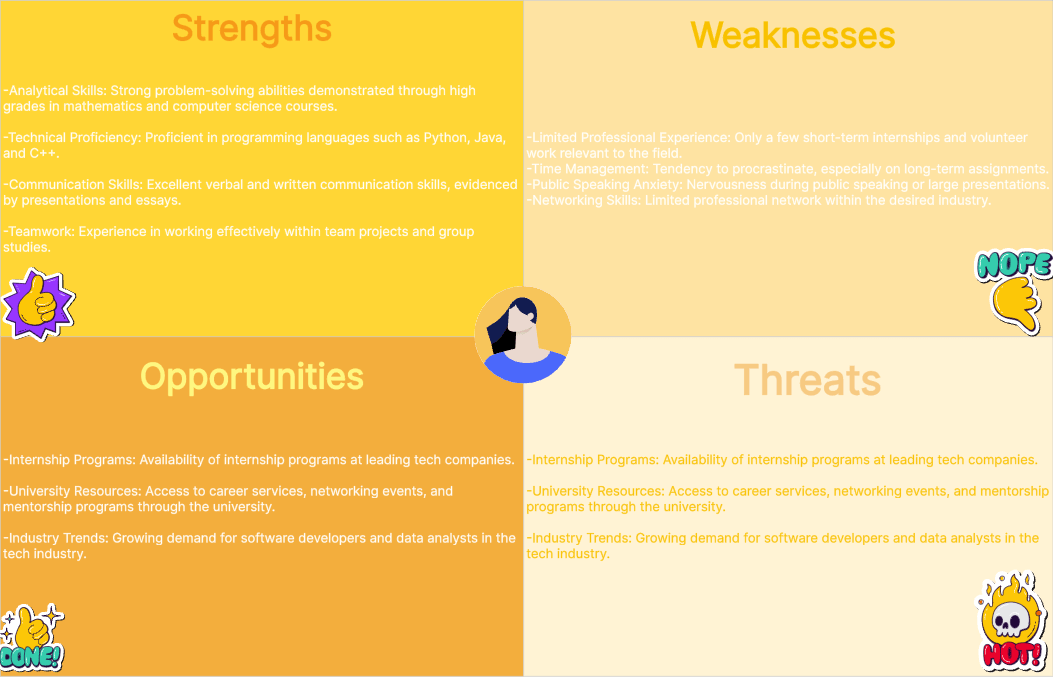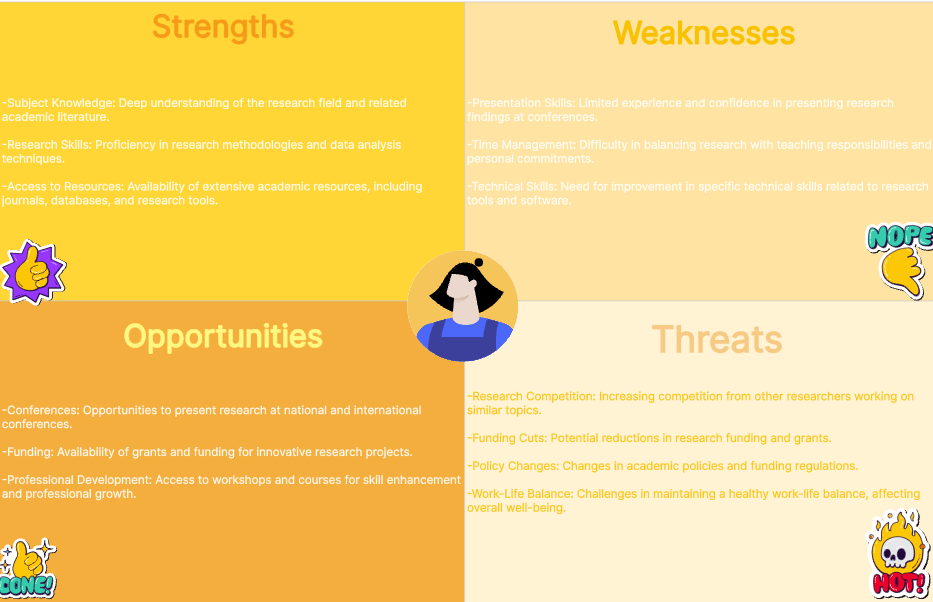Personal SWOT Analysis examples as one powerful tool to help students stand out and achieve their goals. This strategic method, traditionally used in business contexts, helps individuals assess their strengths, weaknesses, opportunities, and threats to create a clear path toward success. By understanding these aspects, students can make informed decisions about their academic and personal development. This article delves into the intricacies of Personal SWOT Analysis, provides detailed examples, and guides students on how to create their analysis.
What is a Personal SWOT Analysis?

A Personal SWOT Analysis is a structured planning method that helps individuals identify and analyze their internal strengths and weaknesses, as well as external opportunities and threats. This analysis provides a comprehensive overview of where a person stands about their goals, allowing them to devise strategies for improvement and success.
Strengths: Internal attributes that contribute positively to achieving goals. For students, these could include skills, knowledge, and personal traits.
Weaknesses: Internal factors that hinder progress. These might be areas where students need improvement or lack resources.
Opportunities: External factors that can be leveraged for success. These include trends, events, or circumstances that can be beneficial.
Threats: External factors that could cause problems or obstacles. These might be competition, changes in the academic environment, or personal challenges.
Personal SWOT Analysis Examples
Personal SWOT Analysis for Students

Example 1: Undergraduate Student Seeking Internship
Strengths✨✨:
-Analytical Skills: Strong problem-solving abilities demonstrated through high grades in mathematics and computer science courses.
-Technical Proficiency: Proficient in programming languages such as Python, Java, and C++.
-Communication Skills: Excellent verbal and written communication skills, evidenced by presentations and essays.
-Teamwork: Experience in working effectively within team projects and group studies.
Weaknesses:
-Limited Professional Experience: Only a few short-term internships and volunteer work relevant to the field.
-Time Management: Tendency to procrastinate, especially on long-term assignments.
-Public Speaking Anxiety: Nervousness during public speaking or large presentations.
-Networking Skills: Limited professional network within the desired industry.
Opportunities:
-Internship Programs: Availability of internship programs at leading tech companies.
-University Resources: Access to career services, networking events, and mentorship programs through the university.
-Industry Trends: Growing demand for software developers and data analysts in the tech industry.
Threats:
-High Competition: Intense competition for internship positions at top companies.
-Rapid Technological Change: Need to continuously update skills to keep up with fast-evolving technology.
-Economic Factors: Potential economic downturn affecting hiring rates and internship availability.
Example 2: High School Student Preparing for College Applications
Strengths✨✨:
-Academic Performance: High GPA and strong performance in advanced placement (AP) courses.
-Leadership: Leadership roles in student government and other school organizations.
-Resilience: Ability to handle academic and personal challenges effectively.
Weaknesses:
-Standardized Testing: Moderate scores on SAT/ACT compared to peers.
-Volunteering: Limited volunteer and community service experience.
-Application Skills: Lack of experience in writing college application essays and preparing for interviews.
Opportunities:
-Scholarships: Various scholarships are available for students with strong academic and extracurricular records.
-Networking: Opportunities to connect with alumni and professionals through school events and online platforms.
-Mentorship: Availability of mentorship programs to guide through the college application process.
Threats:
-Increasing Competition: Rising number of applicants to top-tier colleges.
-Financial Constraints: Potential financial challenges in affording out-of-state or private colleges.
-Admission Policies: Changing admission policies and criteria due to external factors like the pandemic.
Personal SWOT Analysis for Academic

Example: Graduate Student Working on a Research Project
Strengths✨✨:
-Subject Knowledge: Deep understanding of the research field and related academic literature.
-Research Skills: Proficiency in research methodologies and data analysis techniques.
-Access to Resources: Availability of extensive academic resources, including journals, databases, and research tools.
Weaknesses:
-Presentation Skills: Limited experience and confidence in presenting research findings at conferences.
-Time Management: Difficulty in balancing research with teaching responsibilities and personal commitments.
-Technical Skills: Need for improvement in specific technical skills related to research tools and software.
Opportunities:
-Conferences: Opportunities to present research at national and international conferences.
-Funding: Availability of grants and funding for innovative research projects.
-Professional Development: Access to workshops and courses for skill enhancement and professional growth.
Threats:
-Research Competition: Increasing competition from other researchers working on similar topics.
-Funding Cuts: Potential reductions in research funding and grants.
-Policy Changes: Changes in academic policies and funding regulations.
-Work-Life Balance: Challenges in maintaining a healthy work-life balance, affecting overall well-being.
How to Create a Personal SWOT Analysis?
Creating a Personal SWOT Analysis for students involves a structured approach to self-assessment and strategic planning. Here are the steps to create an effective Personal SWOT Analysis example:
1. Self-Assessment
The first step is self-reflection. Take the time to think about your personal and academic experiences, skills, and characteristics. Ask yourself the following questions:
-What are my key strengths?
-What are my weaknesses or areas needing improvement?
-What opportunities are available to me?
-What threats or challenges do I face?
2. Gather Information
To ensure a comprehensive analysis, gather feedback from various sources such as:
-Academic records and performance reports
-Feedback from teachers, mentors, and peers
-Personal reflections and journals
3. Categorize Findings
Organize your findings into four categories: Strengths, Weaknesses, Opportunities, and Threats. You can use a table or matrix to keep everything clear and organized.
Strengths:
-Skills and abilities you excel in
-Personal attributes and positive traits
-Academic achievements and recognitions
-Resources and support systems
Weaknesses:
-Areas where you need improvement
-Skills or subjects you struggle with
Opportunities:
-Academic programs and courses
-Scholarships and financial aid
-Networking events and career fairs
Threats:
-Competition for academic opportunities
-Personal challenges and obstacles
-Changes in academic policies
Economic or environmental factors
4. Analyze and Interpret
After categorizing your findings, analyze how they interact with each other. Consider questions such as:
-How can I leverage my strengths to take advantage of opportunities?
-How can I address my weaknesses to mitigate threats?
-What strategies can I develop to overcome my challenges?
5. Develop Actionable Strategies
Based on your analysis, create specific, actionable strategies to achieve your goals. These strategies should be tailored to your unique strengths, weaknesses, opportunities, and threats. Here are some examples:
Leveraging Strengths: If you excel in a particular subject, consider taking advanced courses or participating in related extracurricular activities.
Addressing Weaknesses: If you struggle with time management, develop a study schedule or seek help from a mentor.
Capitalizing on Opportunities: Apply for scholarships and internships that align with your strengths and interests.
Mitigating Threats: Prepare contingency plans for potential obstacles, such as alternative study methods for difficult subjects.
6. Monitor and Review
A Personal SWOT Analysis example for students is not a one-time exercise. Regularly review and update your analysis to reflect changes in your circumstances, goals, and achievements. This will help you stay on track and adapt to new challenges and opportunities.
Using Boardmix to Create SWOT Analysis
Boardmix offers a user-friendly platform for creating detailed SWOT analyses. Here’s how you can utilize Boardmix for this purpose:

Template Selection: Boardmix provides a variety of SWOT analysis templates that can be customized to suit your needs. Choose a template that fits your personal or academic context.
Customization: Input your strengths, weaknesses, opportunities, and threats into the template. Boardmix allows for easy editing and visualization, making it simple to organize your thoughts and create a personal SWOT analysis example.
Visualization Tools: Use Boardmix’s tools to create visual aids like charts and graphs. This helps in better understanding and presenting your analysis.
Storage and Access: Save your SWOT analysis on Boardmix for future reference and updates. This ensures you can revisit and revise your strategies as needed.
How Can Personal SWOT Analysis Help Students Achieve Academic Goals?
A Personal SWOT Analysis example for students can be a transformative tool for students aiming to achieve their academic goals. By systematically evaluating their internal strengths and weaknesses alongside external opportunities and threats, students can gain a comprehensive understanding of their current situation and devise effective strategies for success. Here are several ways in which a Personal SWOT Analysis can help students achieve their academic goals:
1. Clarifying Strengths and Weaknesses
A Personal SWOT Analysis allows students to identify their core strengths and weaknesses. Understanding their strengths enables students to leverage these qualities in their academic pursuits, such as utilizing strong analytical skills in research projects or using excellent communication skills in group presentations.
2. Strategic Planning
By identifying external opportunities and threats, students can develop strategic plans to navigate their academic journey. Opportunities might include scholarships, internships, or extracurricular activities that can enhance their academic profile. Threats could be competition for limited spots in programs or changes in academic requirements.
3. Goal Setting
A SWOT analysis examples help students set realistic and achievable goals based on a thorough understanding of their strengths, weaknesses, opportunities, and threats. For example, a student might set a goal to improve their GPA by leveraging their strengths in certain subjects while addressing weaknesses through additional tutoring or study groups. By setting specific, measurable, achievable, relevant, and time-bound (SMART) goals, students can create a clear roadmap for academic success.
4. Enhanced Decision Making
With a clear SWOT analysis example for students, students can make informed decisions regarding their studies, extracurricular activities, and career paths. For instance, if a student identifies a strength in creative writing and an opportunity in a writing competition, they might decide to allocate more time to prepare for this competition.
5. Motivation and Focus
A Personal SWOT Analysis example can serve as a motivational tool. By regularly revisiting and updating their SWOT analysis, students can track their progress and celebrate their achievements. This ongoing process helps maintain focus and motivation, as students can see the tangible results of their efforts. Additionally, having a clear understanding of their goals and the steps needed to achieve them keeps students driven and committed to their academic success.
6. Utilizing Boardmix for SWOT Analysis
Using tools like Boardmix can enhance the effectiveness of a Personal SWOT Analysis. Boardmix offers features such as customizable templates, collaboration options, and visualization tools, making it easier for students to create and analyze their SWOT analyses. This digital approach adds an interactive and dynamic element to the SWOT analysis process, further supporting students in achieving their academic goals.
Personal SWOT Analysis is an invaluable tool for students aiming to excel in their academic and personal lives. By systematically evaluating their strengths, weaknesses, opportunities, and threats, students can devise effective strategies to achieve their goals. Tools like Boardmix enhance this process by providing easy-to-use templates and collaboration features. Embracing this analytical approach empowers students to take control of their academic journeys, making informed decisions and setting a clear path toward success.








